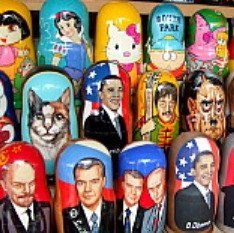Semioticians probably have the best sense of humor among all social scientists. Those who think that the hegemonic discourse in today's Russia is boring are wrong. Some of its segments are quite hilarious and facetious. The key figures in Moscow provide many reasons for irony.
For example, the Russian internet community discussed whether Dmitry Medvedev is upset to know that he is familiarly referred to as “Dimon.” They also provocatively wondered whether Medvedev plays games or takes notes while using his phone and tablet gadgets during government meetings. There was the widely-circulated Easter celebration photo in which Medvedev poses with his wife while Putin is coupled with the Moscow mayor. The comments were, of course, “Putin marries Sobyanin.”
This gives sharpness to discourses of opposition. One of the examples is the well-known Potsreotizm virtual project – a subtle and to some extent post-modernist mockery of the Kremlin's attempts to impose a top-down version of patriotism (http://potsreotizm.livejournal.com). The project's picture gallery is deeply ironic. Putin, definitely far from being a philanthropist, often poses as an animal-lover – kissing a horse or a fish, caressing a puppy or a chick, narcotizing a tiger, etc. People meditatively grin since it gives them a hard time to reconcile his tenderness to animals and cruelty to humans.
Other images are similarly acidic, for example those showing public toilets in a Russian provincial city decorated like Khokhloma lacquer-style paintings. Or crumbling garages painted in the Russian tricolor. Or take the St. George’s ribbon covering a fried chicken dish (presumably cooked for a Great Patriotic War veteran) and even the image of war veteran himself standing in a metro car while all the young people around him are comfortably seated. Another good one is the shockingly twisted text from a Russian textbook for German-language classes where students are requested to translate the phrase: “As long as Putin stays in power, it's going to be okay.”
Humor is far from being a means of last resort. It has value. It performs two major functions simultaneously. It deconstructs hierarchies of power and expands the circle of protesters by constantly involving new audiences. This is exactly what makes humar narratives so powerful. It seems that a huge part of the protest activity in today's Russia contains deep irony.
Political humor is one of the most workable means of communication. Take the recent massive public yoga session held not long ago in Moscow under the slogan: “Turn your back to the Kremlin.” Or take the series of scandalous posters portraying Russia as an erratic bear preparing to host the Sochi Olympics (http://www.znak.com/perm/news/2013-06-05/1006790.html).
The state both constructs and deconstructs state identity by giving multiple reasons for mockery and sarcasm. Apparently, Putin underestimated the force of public mockery. When he compared the white ribbon protestors with vendors of contraceptives, it was only logical that street demonstrators reciprocated by decorating his portraits accordingly.
We know that the delegitimation of the Soviet rule started with ridiculing the regime. Yet we also know that jokes and humor can play relieving and stabilizing functions. The famous journal Krokodil was meant to incorporate humor into the official narrative of those times. The experience of the late Soviet Union tells us that the current regime is unlikely to hold political humor under control. At some point it becomes a discursive force of its own, with quite consequential political effects.
(Quite a few of the semiotic examples here were derived from the annual Yurii Lotman conference held recently at the University of Tallinn.)
Andrey Makarychev is a Professor at the Institute of Government and Politics, University of Tartu, blogging for PONARS Eurasia on the Russia-EU neighborhood.









